The assault on the Nikopol bridgehead and the defeat of the German 6th Army
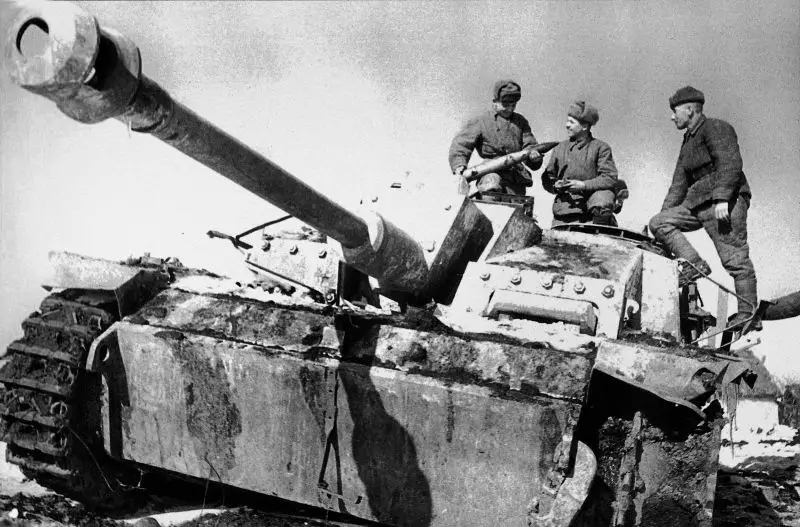
General situation
Almost at the same time when the Korsun-Shevchenko operation was going on (Defeat of the German 1st Tank and 8th Field Armies in the Battle of Korsun-Shevchenko), troops of the 3rd and 4th Ukrainian Fronts under the command of Rodion Malinovsky and Fyodor Tolbukhin fought stubborn battles against the Nikopol-Krivoy Rog enemy group. Their actions were coordinated by Alexander Vasilevsky.
After the Melitopol operation of 1943 (Assault on "Little Stalingrad"), during which the German troops were defeated, the German 6th Army gained a foothold in a salient in the great bend of the Dnieper and on the Nikopol bridgehead.
Hitler ordered to hold iron and manganese deposits in the Nikopol area at any cost. The Fuhrer repeatedly emphasized the strategic importance of Nikopol manganese for the Third Reich. The Germans not only did not intend to leave the bridgehead on the left bank of the Dnieper, but did everything to turn it into a powerful fortified area, creating an almost continuous system of strong points, well prepared in engineering terms.
The German command did not lose hope of restoring contact with the Crimean group with the help of this bridgehead. During the first half of January 1944, the Red Army made more than one attempt to dislodge the German 6th Army from this bridgehead.
So, on January 10, the 3rd UV struck in the direction of Apostolovo. On January 11, the 4th UV attacked the enemy on the Nikopol bridgehead. Stubborn fighting raged for several days. However, the Soviet troops failed to achieve any tangible results. This was explained not only by the strong German defense, but also by the significant shortage of Soviet military formations in manpower and equipment, especially in tanks... There was also a lack of ammunition. Therefore, it was decided to stop the offensive in order to prepare more thoroughly for the next strike.
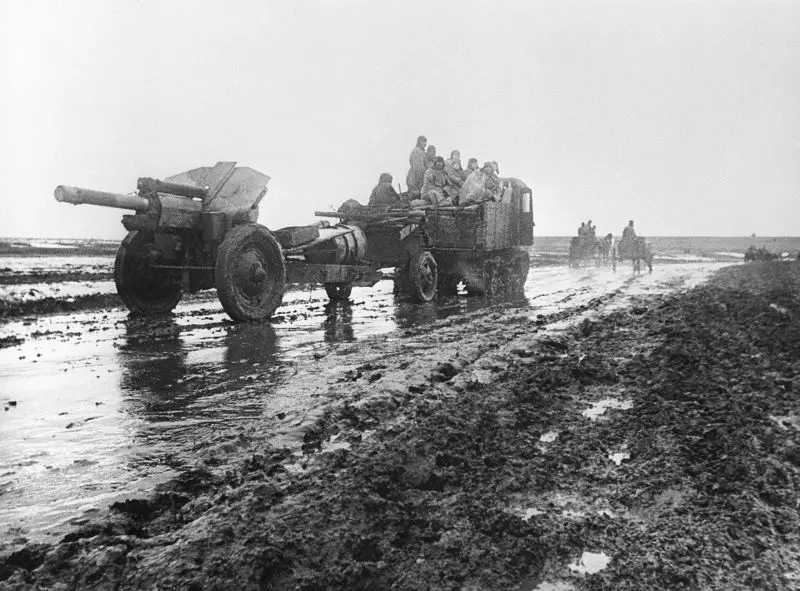
A Soviet tractor (STZ-5 NATI) tows a 122 mm M-30 howitzer on the road to Nikopol.
German forces
The basis of the Nikopol-Krivoy Rog group was the 6th Army under the command of Karl-Adolf Hollidt, which was part of Army Group South. The army included: 29th, 4th, 17th Army Corps, Corps Group "Schwerin", 40th and 57th Tank Corps. In total, the army had 17 infantry, 4 tank, 1 motorized divisions and other formations. The group consisted of about 540 thousand soldiers, more than 2,4 thousand guns and mortars, 327 tanks and assault guns, and about 700 aircraft. From the air, the Nikopol-Krivoy Rog group was supported by the 1st aviation 4th air corps fleet.
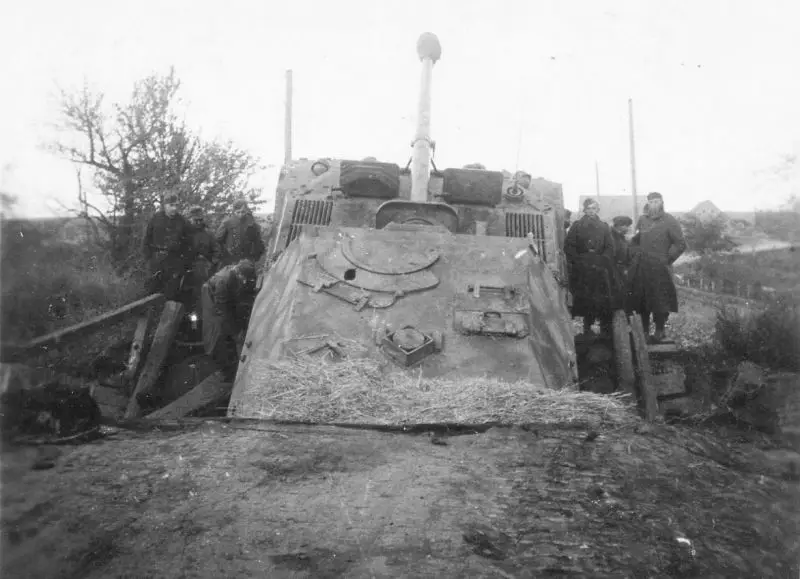
German self-propelled gun "Ferdinand", which failed on a wooden bridge in the Nikopol area. Autumn 1943
The Nikopol bridgehead itself was defended by F. Scherner’s task force - 8 infantry divisions and 3 assault gun divisions.
The Germans had a strong defense in this direction. The front line had three rows of trenches and trenches protected by barbed wire and minefields. On the basis of the Dnieper and Kamenka rivers, auxiliary defensive lines were created. Settlements and important heights were turned into strong points and nodes of resistance.
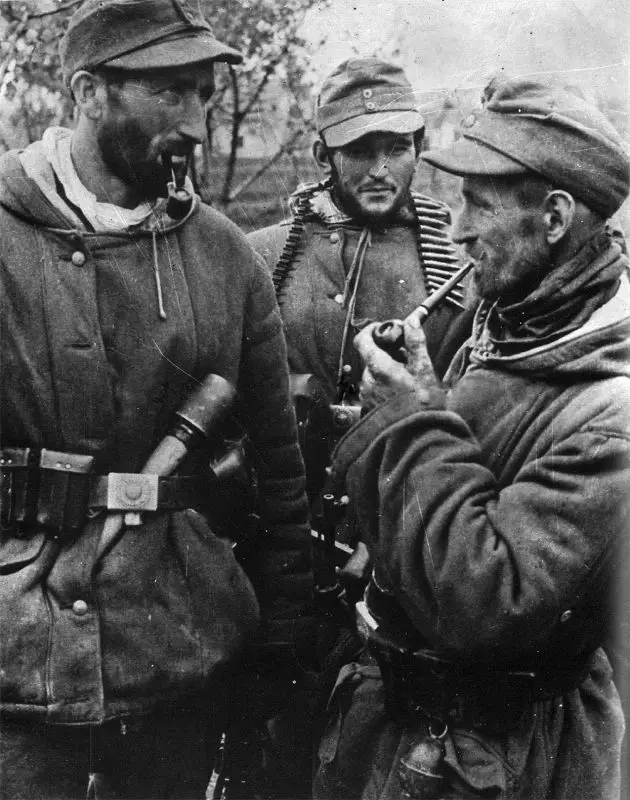
German mountain rangers during the fighting in the Nikopol area. Autumn 1943
Soviet forces
The 3rd UV occupied positions from Vesely Ternov to Belenky. The 3rd UV included: Sharokhin's 37th Army, Glagolev's 46th Army, Chuikov's 8th Guards Army, Shlemin's 6th Army. The front was covered from the air by the 17th Air Army of Sudets.
Malinovsky's front was significantly strengthened. He was given the 2th Army of Sharokhin from the 37nd UV, the 4th Guards Mechanized Corps of Tanaschishin from the 4th UV, and the 31st Guards Rifle Corps from the reserve of the Supreme High Command (VGK). Already during the offensive, on February 10, the 3rd UV was transferred from the 4th UV - the 3rd Guards Army of Lelyushenko and the 5th Shock Army of Tsvetaev.
Part of the forces of the 4th UV also took part in the operation: Lelyushenko’s 3rd Guards Army and Tsvetaev’s 5th Shock Army (until February 10), Grechkin’s 28th Army, Sviridov’s 2nd Guards Mechanized Corps. The front was supported from the air by Khryukin's 8th Air Army. Tolbukhin's front initially occupied the line of Blagoveshchenskoye, Verkhniy Rogachik and Gornostaevka.
In total, there were more than 700 thousand people in two fronts, about 7,8 thousand guns and mortars, 238 tanks and SAU, over 1,3 thousand aircraft. Soviet troops had an advantage in infantry, artillery and aircraft, but by the number of tanks inferior to the Germans.
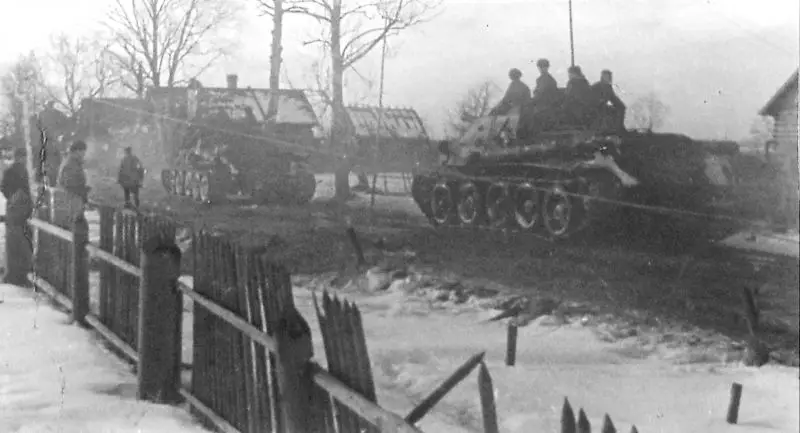
A column of Soviet self-propelled guns SU-122 on the street of a Ukrainian village. 1944
Operation plan
On January 17, 1944, the military council of the 3rd Ukrainian Front and Headquarters representative Alexander Vasilevsky sent an operation plan to the Supreme High Command Headquarters. The troops of the two fronts had to deliver converging attacks in order to encircle and destroy the enemy forces located on the Nikopol-Krivoy Rog bridgehead. Malinovsky's troops were to play a decisive role in the operation. The main blow was delivered by Chuikov's 8th Guards Army and Glagolev's 46th Army. They advanced from the Novaya Nikolaevka - Vladimirovka area on a 21 km section in the general direction to Apostolovo. The 37th Army launched an auxiliary attack in the Krivoy Rog direction, and the 6th Army in the Nikopol direction.
The 4th UV was supposed to launch an offensive with the development of success by the forces of the 3rd UV in order to pin down the enemy forces. The 3rd Guards Army was supposed to attack Nikopol, the 5th Shock Army was to attack Malaya Lepetikha, and the 28th Army was to attack Bolshaya Lepetikha.
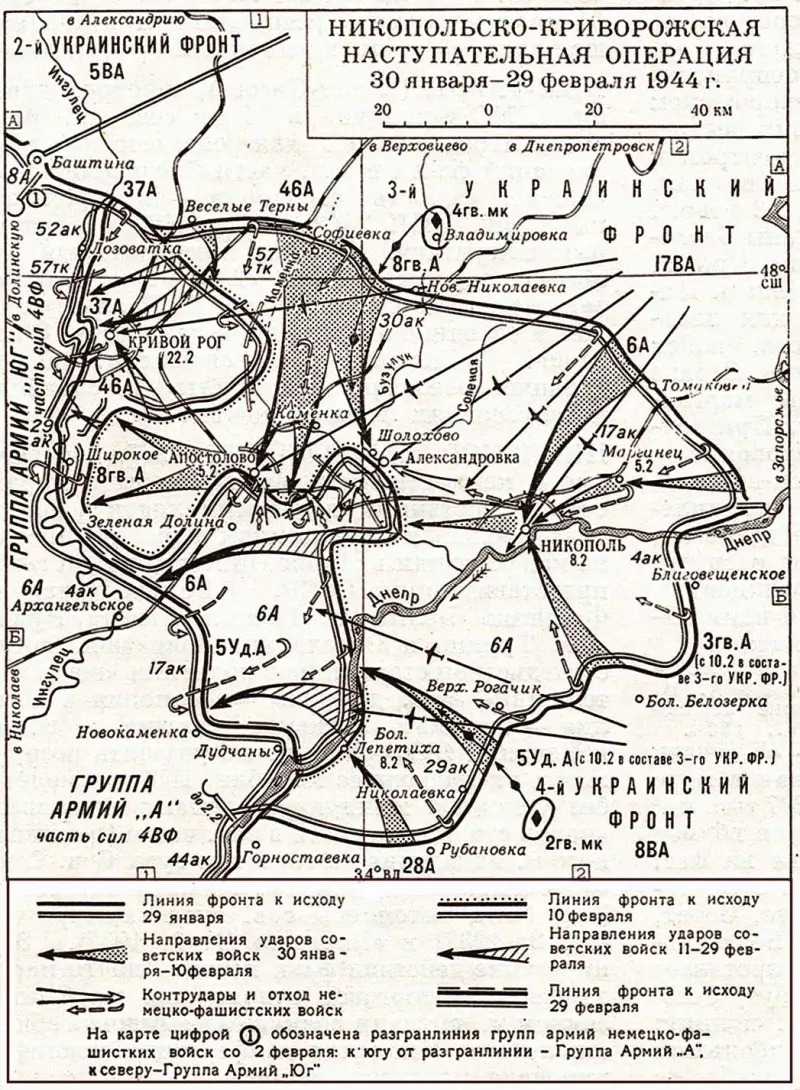
Defense breakthrough
On the morning of January 30, 1944, the 6th and 37th armies went on the offensive, distracting the Germans from the main direction of attack. Front-line aviation actively processed these areas. Shlemin's army advanced 3–4 km in a day. Units of Sharokhin's army advancing from the Vesyye Terny area were more successful. The 82nd Rifle Corps broke through the enemy's defenses in an 8-kilometer area and advanced 20 km.
The German command, believing that the Russians had decided to deliver the main blow in the Krivoy Rog direction, deployed the reserve 37th and 9rd tank divisions (23 tanks) against the 180th Army. Stubborn fighting ensued. This greatly facilitated the breakthrough of enemy defenses in the main direction. It is also necessary to take into account the fact that the command of Army Group South took a number of mobile formations to the rescue of the Korsun-Shevchenko group.
On January 46, the 8th and 30th Guards Armies, with reinforced battalions, carried out reconnaissance in force. On the morning of January 31, a powerful 50-minute artillery preparation was organized. Aviation carried out strikes on enemy positions, fortified facilities, railway junctions and airfields. By the end of the day, the German defenses had been broken through to a depth of 20 km. Building on the success, the front command brought the 4th Guards Mechanized Corps into the breakthrough. By the end of February 1, Tanaschishin’s corps reached Kamenka and Sholokhov. Fighting ensued for their release.
The offensive of the Soviet troops developed in muddy conditions. Vasilevsky recalled:
Realizing that they had been deceived, the Germans tried to close the breakthrough with tank divisions, which they first threw against the 37th Army. Also, from the reserves of Army Group South, they began to transfer the 24th Tank Division, which had previously been sent to rescue the Korsun-Shevchenko group. But the moment was already lost.
The situation was already developing for the Nazis according to a catastrophic scenario. Their defenses collapsed. By the end of February 2, the Red Army liberated Sholokhovo, Kamenka and a number of other settlements. The 16th Motorized Division and four infantry divisions were destroyed. Some German units began to show signs of panic. There was a threat of encirclement of the 6th Army.
By the evening of February 4, Soviet troops reached the important railway junction of Apostolovo. It was defended by the remnants of the 9th Tank and 123rd Infantry Divisions. The German group consisted of up to 3 thousand soldiers, a significant number of guns, tanks and assault guns. It was a tough nut to crack. Apostolovo was an important supply base for the 6th Army.
With the help of local residents, our scouts discovered a gap in the German defenses. Soviet troops maneuvered behind enemy lines and launched a surprise attack early on the morning of February 5th. By 8 o'clock in the morning, the troops of the 46th Army had completely captured Apostolovo. About 700 Germans were captured, a large number were captured weapons and technology.
Thus, as a result of six days of fighting, Soviet troops broke through the German defenses on a wide front, advanced 45–60 km, and defeated several enemy divisions. The 6th German Army was split into two parts, and there was a threat of a blockade of the German divisions defending in the area of Marganets, Nikopol. The German command began to hastily withdraw troops to the southwest along the right bank of the Dnieper.
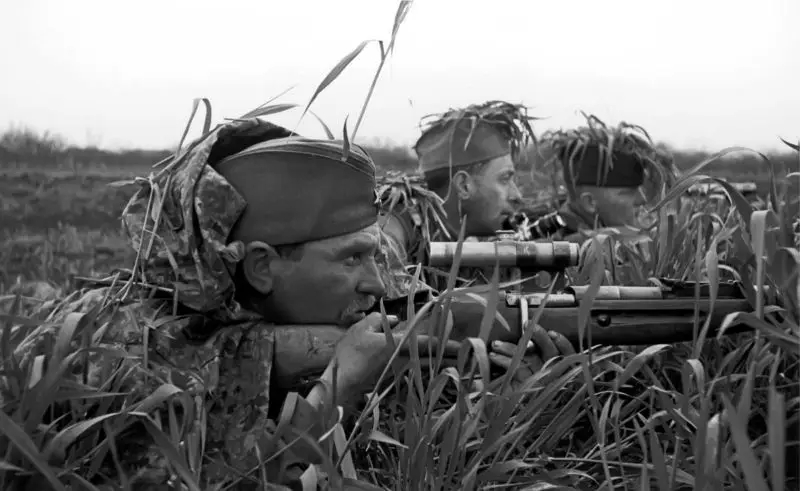
Snipers of the 203rd Rifle Division (3rd Ukrainian Front), senior sergeant Ivan Petrovich Merkulov and sergeant Ardalion Vladimirovich Zolotov at a firing position. In March 1944, Ivan Merkulov was awarded the highest award - the title of Hero of the Soviet Union; during the war years, the sniper destroyed more than 144 enemy soldiers and officers. Ukraine. 1944
Liberation of Nikopol
Glagolev's 46th Army continued its offensive in a western direction, towards the Ingulets River. The 8th Guards Army of Chuikov with the 4th Guards Mechanized Corps of Tanaschishin moved to the Dnieper in order to, in cooperation with the forces of the 4th UV, encircle the Nikopol enemy group.
Tolbukhin's front went on the offensive on January 31. The German command still sought to hold the Nikopol bridgehead, so the fighting became fierce from the very beginning. In the afternoon, Sviridov’s 5nd Guards Mechanized Corps was brought into battle in the offensive zone of the 2th Shock Army. By the end of the day he had advanced 11–14 km.
Considering the difficult situation in the offensive sector of the 3rd UV, the Germans began to withdraw some of their forces to help the troops defending to the north and withdraw units to the crossings at Nikopol and Bolshaya Lepetikha. Soviet troops pursued the enemy. At the crossings across the Dnieper there was complete hell. The roads were clogged with soldiers, equipment and military equipment.
The planes of the 8th and 17th Air Armies carried out raids continuously, bombing and shooting the enemy. Huge traffic jams arose from blazing cars, carts, and various property. The soldiers panicked and abandoned their heavy weapons and vehicles. The activity of Soviet aviation is evidenced by the number of sorties: January 31 – February 8, Soviet pilots carried out 2 sorties against 618 enemy sorties. The planes were joined by Soviet artillerymen, who fired concentrated fire at the crossings.
The German command still managed to organize strong bridgeheads from the units that retained their combat capability. German troops, suffering heavy losses and abandoning equipment and property, retreated beyond the Dnieper. A disaster was avoided. On the morning of February 8, the Red Army liberated the regional center of the Zaporozhye region, Bolshaya Lepetykha.
Thus, the enemy’s Nikopol bridgehead was eliminated. The Germans lost about 14 thousand people killed and more than 1 thousand captured. 24 tanks, 550 guns and mortars, and many other equipment and weapons were captured.
On February 8, troops of the 6th Army of the 3rd UV and the 3rd Guards Army of the 4th UV liberated Nikopol. Having lost Nikopol, the Nazis faced the threat of another catastrophe. The offensive of the 8th Guards Army could cut off the retreat routes of the German troops. There were fierce battles. Part of the forces of the German group defended against the troops of Shlemin’s 6th Army, the main forces (the remnants of 6 infantry and 2 tank divisions) sought to prevent Chuikov’s army from breaking through to the Dnieper floodplains.
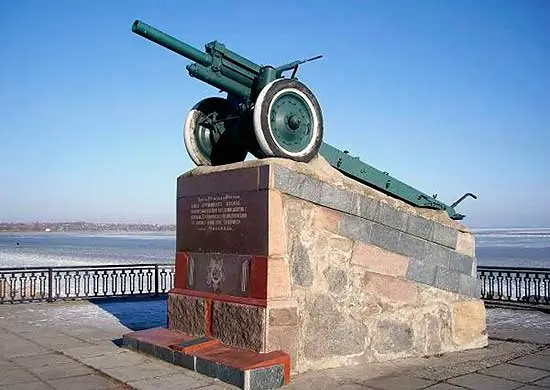
War Memorial "Cannon". Installed in honor of the memory of the Nikopol-Krivoy Rog operation. Nikopol, embankment of the Kakhovka reservoir
Liberation of Krivoy Rog
The German command organized a counterattack in the Apostolovo area. On February 11, 2 tank and 4 infantry divisions struck at the junction of the advancing 46th and 8th Guards armies. By the end of the day they were able to advance 8–10 km.
The command of the 3rd UV sent from its reserve the 48th Guards Rifle Division and two anti-tank artillery regiments to the area of the German counteroffensive. The German counterattack was repelled. But the Germans gained time. German troops, under continuous attacks from Soviet aviation and artillery, suffering heavy losses in manpower and equipment, managed to escape the cauldron and retreated to Dudchino.
German General Tippelskirch noted that the defeat in the Nikopol area was comparable in scale to the disaster of the 8th Army in the Korsun-Shevchenkovsky area.
On February 10, the 3rd Guards Army and the 5th Shock Army were transferred to the 3rd UV. The 37th Army continued fighting in the Veselye Terny area, the 46th Army and the 8th Guards Army near Apostolovo. The 6th Army reached the Novaya Vorontsovka area. The 5th Shock Army occupied and held a bridgehead on the right bank of the Dnieper. The front command was preparing an operation to liberate Krivoy Rog. It took several days to prepare the operation. They brought up artillery, brought up ammunition and fuel.
The Nazis concentrated five infantry and two tank divisions in the Krivoy Rog direction. Constantly counterattacking Soviet troops, the Germans hastily strengthened the defenses around the city.
On February 17, the 37th and 46th armies went on the offensive again. They had to move through mud and wet snow, so the troops moved slowly. On the night of February 19, the German command began to withdraw troops. On February 22, Krivoy Rog was liberated from the Germans.
During this offensive, the Soviet command paid special attention to the rapid liberation of the Krivoy Rog State District Power Plant and the dam on the Saksagan River near the power plant. It was impossible to let the enemy destroy this most important facility. To save the state district power plant, a special detachment was formed under the command of the deputy chief of the operational department of the headquarters of the 37th Army, Lieutenant Colonel A. N. Shurupov. On the night of February 22, Soviet soldiers crossed the Saksagan River 400 m south of the dam. The Germans discovered them and surrounded them. For two days the Soviet detachment repelled enemy attacks. The task was completed. The dam explosion was prevented.
By February 25–29, the armies of the 3rd Ukrainian Front entered the Ingulets River and captured a number of bridgeheads on the right bank. Thus, units of the 37th Army occupied bridgeheads west of Krivoy Rog, the 46th Army north of Shirokoe, and the 8th Guards Army west of Shirokoe. The 5th Shock Army reached the line Bolshaya Alexandrovka, Dudchino. As a result, the Germans were unable to gain a foothold on the Ingulets River. The Red Army created favorable conditions for a strike in the Nikolaev-Odessa direction. The operation was completed.
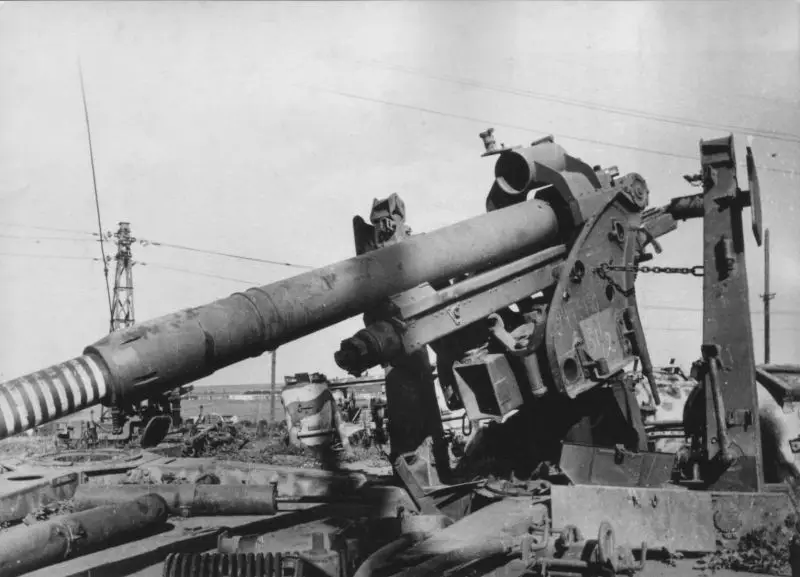
German 88-mm anti-aircraft gun FlaK 36, destroyed on the territory of the Krivorozhstal metallurgical plant in Krivoy Rog. On the gun barrel there are marks (white stripes) about downed aircraft.
Results
As a result of the Nikopol-Krivoy Rog operation, 12 German divisions were defeated (including 3 tank and 1 motorized). Soviet troops destroyed the enemy's Nikopol bridgehead. The economically important Nikopol and Krivoy Rog industrial areas were returned to the Soviet Union. Conditions were created for the liberation of the Crimean peninsula and an offensive in the Nikolaev-Odessa direction.
The German 6th Army lost about 60 thousand people killed, about 4,6 thousand people were captured. German divisions lost almost all heavy weapons and vehicles. The 6th Army had largely lost its combat effectiveness, but escaped the cauldron. The German command finally said goodbye to the hope of restoring land communications with the 17th Army blocked in the Crimea. Soviet losses are unknown.
From the point of view of military art, the operation is interesting in that the Soviet command managed to mislead the enemy and hide the direction of the main attack. It should also be noted that the operation was carried out in the most severe weather conditions, with the superiority of the enemy in tank units.
For the courage and heroism shown by the troops of the 3rd and 4th Ukrainian Fronts in the Nikopol-Krivoy Rog offensive operation, 28 formations and units of the Red Army received the honorary names of Krivoy Rog and Nikopol. Moscow saluted the Soviet liberating soldiers with twenty artillery salvoes from 224 guns.
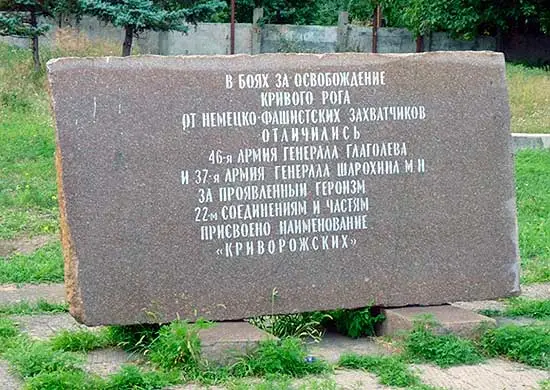
Alley of military units liberating the city of Krivoy Rog
Information